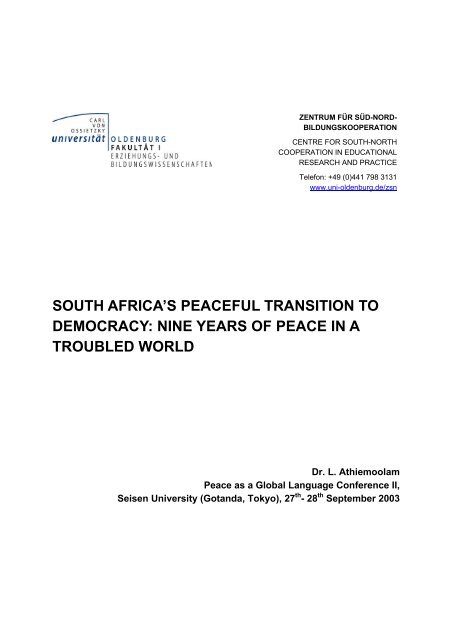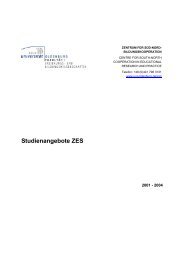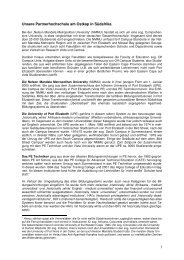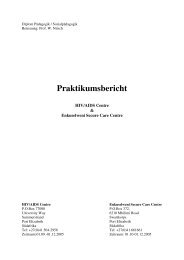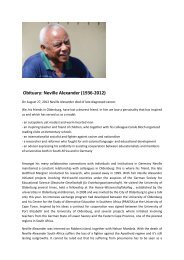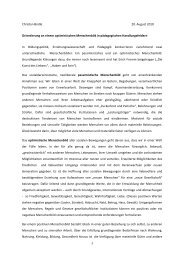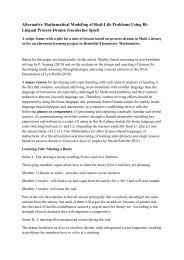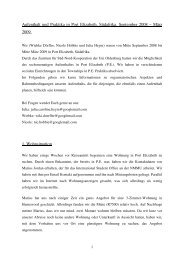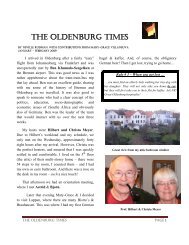south africa's peaceful transition to democracy - Zentrum für Süd ...
south africa's peaceful transition to democracy - Zentrum für Süd ...
south africa's peaceful transition to democracy - Zentrum für Süd ...
Create successful ePaper yourself
Turn your PDF publications into a flip-book with our unique Google optimized e-Paper software.
ZENTRUM FÜR SÜD-NORD-<br />
BILDUNGSKOOPERATION<br />
CENTRE FOR SOUTH-NORTH<br />
COOPERATION IN EDUCATIONAL<br />
RESEARCH AND PRACTICE<br />
Telefon: +49 (0)441 798 3131<br />
www.uni-oldenburg.de/zsn<br />
SOUTH AFRICA’S PEACEFUL TRANSITION TO<br />
DEMOCRACY: NINE YEARS OF PEACE IN A<br />
TROUBLED WORLD<br />
Dr. L. Athiemoolam<br />
Peace as a Global Language Conference II,<br />
Seisen University (Gotanda, Tokyo), 27 th - 28 th September 2003
SOUTH AFRICA’S PEACEFUL TRANSITION TO DEMOCRACY: NINE<br />
YEARS OF PEACE IN A TROUBLED WORLD<br />
It is our privilege as South Africans <strong>to</strong> be living at a time<br />
when our nation is emerging from the darkest night in<strong>to</strong><br />
the bright dawn of freedom and <strong>democracy</strong>. The onus is<br />
on us, through hard work, honesty and integrity, <strong>to</strong> reach for<br />
the stars.<br />
Nelson Mandela<br />
This paper aims <strong>to</strong> first and foremost provide the background <strong>to</strong> South Africa’s <strong>peaceful</strong><br />
<strong>transition</strong> <strong>to</strong> <strong>democracy</strong>, highlight the reasons for the successes and thereafter <strong>to</strong> focus<br />
on the policies adopted by the democratically elected government in their quest <strong>to</strong><br />
dismantle the pillars of apartheid so that human rights and dignity could be upheld in<br />
post apartheid South Africa. Prior <strong>to</strong> 1994 South Africa became synonymous with some<br />
of the most gruesome and heinous human rights violations known <strong>to</strong> man. However,<br />
since 1994 with the demise of the apartheid system and the implementation of<br />
<strong>democracy</strong> in the country the democratically elected government has gone <strong>to</strong> great<br />
lengths <strong>to</strong> ensure that the past discrimina<strong>to</strong>ry practices were removed from the statute<br />
books and have made concerted efforts <strong>to</strong> pass and implement various policies and acts<br />
aimed at ensuring that all citizens irrespective of race, colour or creed could enjoy their<br />
rights as citizens in a unified, non-racist, non-sexist South Africa.<br />
The post- apartheid government has largely been successful in ensuring that the citizens<br />
enjoyed freedom of speech, a just and free society and a transparent political system.<br />
This has been safeguarded by the democratic constitution and the various acts and<br />
policies that were passed in parliament. The paper aims <strong>to</strong> provide the essence of some<br />
of these policies, specifically those focusing on human rights issues and <strong>to</strong> assess the<br />
extent <strong>to</strong> which they have been able <strong>to</strong> make a meaningful contribution <strong>to</strong> improving the<br />
lives of the previously disadvantaged and oppressed members of South African society.<br />
The paper argues that in spite of the many challenges which the post apartheid<br />
government had <strong>to</strong> contend with, it has made tremendous strides in addressing racial<br />
discrimination in society by implementing a multicultural constitution and by passing acts<br />
such as the anti-discrimination act which aims at ensuring that all people are treated<br />
equitably. The truth and reconciliation commission has played a significant role in<br />
making all the citizens in the country aware of the gross human rights violations<br />
2
perpetrated during the apartheid era, thereby serving <strong>to</strong> remind people of the disastrous<br />
consequences of such horrendous policies on the lives of ordinary people. In spite of<br />
the many successes that have been achieved thus far, much more still needs <strong>to</strong> be done<br />
in order <strong>to</strong> ensure that the country becomes a glowing example <strong>to</strong> the rest of the world.<br />
Introduction<br />
South Africa’s decisive democratic transformation has inspired hope for civility around<br />
the world. Few predicted such dramatic progress, given the long and bloody his<strong>to</strong>ry of<br />
struggle over apartheid. Indeed, South Africa was widely expected <strong>to</strong> succumb <strong>to</strong> the<br />
ethnic violence that afflicts so many nations when repression begins <strong>to</strong> yield <strong>to</strong><br />
revolution. Today, there are major civil wars raging in various parts of Africa and across<br />
the globe and international terrorism has plunged both the developed and the<br />
developing world in<strong>to</strong> a state of anarchy. If we hope <strong>to</strong> create a <strong>peaceful</strong> world free from<br />
oppression, hatred, bitterness, enmity and wars we need <strong>to</strong> make concerted efforts <strong>to</strong><br />
find ways of preventing conflicts and resolving differences by democratic means. Thus,<br />
South Africa’s experiences on the road <strong>to</strong> <strong>democracy</strong> may offer some invaluable insights<br />
in this regard.<br />
The apartheid regime that unleashed a reign of terror for over forty years and<br />
incarcerated multitudes of people, could rightfully be regarded as one of the most<br />
heartless and ruthless regimes that the world has ever seen since the reign of Hitler in<br />
Germany. It is with this background in mind that South Africa’s <strong>peaceful</strong> <strong>transition</strong> <strong>to</strong><br />
<strong>democracy</strong> was indeed a miracle that captured the imagination of people all over the<br />
world.<br />
This paper first and foremost proposes <strong>to</strong> provide a brief background <strong>to</strong> the legislation<br />
that led <strong>to</strong> the suppression of millions of people in South Africa during the apartheid era<br />
and then <strong>to</strong> provide an outline of some of the acts that have been adopted since the first<br />
democratic elections in 1994. The paper also proposes <strong>to</strong> evaluate the successes of the<br />
legislation thus far and <strong>to</strong> assess South Africa’s contribution <strong>to</strong> peace and stability in<br />
Africa and internationally.<br />
BRIEF HISTORICAL BACKGROUND AND APARTHEID LEGISLATION<br />
3
His<strong>to</strong>rical Background<br />
The his<strong>to</strong>ry of discrimination and racial prejudice against the indigenous population of<br />
South Africa has its roots in the arrival of the first Europeans from Holland in 1652. Later<br />
during subsequent Dutch and British domination of the Cape Colony racial discrimination<br />
against the indigenous inhabitants especially the Khoikhoi and the San was intensified.<br />
The descendents of the Dutch, who became known as Boers, were dissatisfied with the<br />
British hold over South Africa in the mid 1800’s and established their own inland<br />
colonies later.<br />
Clashes between the British coastal colonies and the inland states established by the<br />
Boers culminated in the Boer war (1899-1902), in which British authority was extended<br />
over the Afrikaners. In 1910, the four areas of the country were united as the Union of<br />
South Africa of the British Empire. An uneasy power-sharing between the Englishspeakers<br />
and the Boers (who called themselves Afrikaners) held sway until the 1940s,<br />
when the Afrikaner National Party was able <strong>to</strong> gain a strong majority.<br />
After the Afrikaner National Party came in<strong>to</strong> power in 1948, racial discrimination was<br />
institutionalised. Strategists in the National Party invented apartheid as a means <strong>to</strong><br />
cement their control over the economic and social system. Initially, the aim of apartheid<br />
was <strong>to</strong> maintain white domination while extending racial separation. Starting in the<br />
1960s, a plan of “Grand Apartheid” was executed, emphasising terri<strong>to</strong>rial separation<br />
and police repression. Race laws <strong>to</strong>uched every aspect of social life – for example, not<br />
only was marriage prohibited between whites and non-whites, but the Immorality Act<br />
forbade any sexual contact between blacks and whites. In addition certain jobs were<br />
classified as for whites only.<br />
Acts passed during the apartheid era<br />
Many laws and acts were passed during the apartheid era which undermined the<br />
position of the non-white population and effectively reduced them <strong>to</strong> second class<br />
citizens. Rampant discrimination and gross human rights violations characterised<br />
National Party rule from 1948 <strong>to</strong> 1994. Some of the acts designed by parliament <strong>to</strong><br />
safeguard white privilege and supremacy included the following:<br />
• The South Africa Act was <strong>to</strong> ensure that an all-white government ruled the country<br />
4
• The Population Registration Act required that all South Africans be classified in<strong>to</strong><br />
one of four categories: white, black (African), Asian or Coloured (of mixed descent)<br />
• The Mines and Works Act banned certain jobs for certain races and also made sure<br />
that white people always had a higher salary than black people<br />
• The Natives Lands Acts gave whites over 90% of the land of South Africa leaving<br />
only about 10% of the land for the other races.<br />
• The Natives (Urban Areas) Act declared residential segregation and forced blacks<br />
<strong>to</strong> carry a paper that allowed them <strong>to</strong> stay in the cities<br />
• The Natives Laws Amendment Act established a system of pass-laws where the<br />
blacks had <strong>to</strong> carry a special identification pass if they wanted <strong>to</strong> enter white areas<br />
• Prohibition of Mixed Marriages Act forbade marriages between blacks and whites<br />
• The Group Areas Act segregated the four races namely (Whites, Coloureds,<br />
Indians and Blacks) and created geographical borders between the people. This<br />
meant that people of different races were not allowed <strong>to</strong> live, work or even enter a<br />
property that belonged <strong>to</strong> a person of a different race.<br />
• Criminal Law Amendment Act gave permission <strong>to</strong> the police <strong>to</strong> give severe<br />
punishment <strong>to</strong> those who protested against apartheid.<br />
• Reservation of Separate Amenities Act segregated people on buses, and in<br />
schools, parks and many other places.<br />
• The Bantu Education Act forced racial segregation in schools and provided blacks<br />
with gutter education so that they would be the labourers.<br />
• Natives Resettlement Act relocated the majority of the blacks in <strong>to</strong> their ethnic<br />
backgrounds<br />
• Industrial Conciliation Act allowed jobs <strong>to</strong> be reserved for certain races and gave<br />
white people priority for jobs<br />
• The Bantu Homelands Citizenship Act aimed <strong>to</strong> make every black person a civilian<br />
of a homeland rather than a citizen of South Africa<br />
• Constitutional Act divided the South African parliament in<strong>to</strong> three groups namely<br />
whites, Coloured and Asians, but blacks were denied any representation.<br />
5
The end of apartheid<br />
In the mid 1980s the U.S and the European Community (now European Union) imposed<br />
sanctions against South Africa. Diplomatic pressure and internal violence convinced<br />
President P.W. Botha <strong>to</strong> begin dismantling apartheid. This caused many whites <strong>to</strong><br />
defect <strong>to</strong> more conservative parties. After Botha’s resignation in 1989, F.W de Klerk, his<br />
successor, continued the policy of ending apartheid. In 1990 de Klerk ended a 30-year<br />
ban on the African National Congress (ANC) and released its leader, Nelson Mandela,<br />
from prison.<br />
By the end of 1991 the legal framework of apartheid had been revoked. In a March<br />
1992 referendum a majority of whites endorsed de Klerk’s reforms. Despite continued<br />
violence, negotia<strong>to</strong>rs led by Mandela and de Klerk agreed in 1993 on a timetable for the<br />
implementation of majority rule. After a plea from Mandela at the UN in September,<br />
remaining international sanctions on South Africa were lifted. In Oc<strong>to</strong>ber de Klerk and<br />
Mandela were awarded the Nobel Peace Prize.<br />
In December 1993 the South African parliament passed an interim constitution that gave<br />
equal rights <strong>to</strong> all South Africans and abolished the homelands. In April 1994 the ANC<br />
won South Africa’s first democratic elections and in May the National Assembly chose<br />
Mandela <strong>to</strong> head a government of National Unity, including de Klerk as his second<br />
deputy preseident.<br />
THE POST-APARTHEID ERA: ACTS PASSED TO ENSURE EQUITY IN<br />
SOCIETY<br />
Since the democratic elections of 1994, the government passed various acts in order <strong>to</strong><br />
effect transformation in society and <strong>to</strong> remove all past discrimination policies from the<br />
statute books. The dismantling of the apartheid policies was a tedious and long drawn<br />
out process as parliament grappled <strong>to</strong> rescind the multitudes of discrimina<strong>to</strong>ry acts and<br />
<strong>to</strong> replace them with acts that would uphold the principles of <strong>democracy</strong>, justice and<br />
equality in an erstwhile divided and racially stratified society. These acts focused on<br />
rectifying the inequalities of the past by providing opportunities for previously<br />
disadvantaged groups <strong>to</strong> enjoy rights and freedoms hither<strong>to</strong> denied <strong>to</strong> them. The<br />
corners<strong>to</strong>nes of these rights and freedoms are highlighted in the constitution, surely one<br />
of the most liberal in the developed world.<br />
6
Constitution of the Republic of South Africa, Act 108 of 1996<br />
The Government of National Unity that emerged after the first democratic elections<br />
worked tirelessly and effortlessly <strong>to</strong> fashion a constitution that would make a meaningful<br />
contribution <strong>to</strong>wards galvanising the nation in<strong>to</strong> a coherent whole. The corners<strong>to</strong>nes of<br />
ex-President Mandela’s reign became synonymous with reconciliation and nation<br />
building and these two tenets manifested themselves most succinctly in the constitution<br />
of South Africa.<br />
In chapter 1 of the Constitution (1996:146) the following four values are regarded as the<br />
corners<strong>to</strong>nes upon which the country are founded:<br />
(a)<br />
(b)<br />
(c)<br />
(d)<br />
Human dignity, the achievement of equality and the advancement of<br />
human rights and freedoms<br />
Non-racialism and non-sexism<br />
Supremacy of the constitution and the rule of law<br />
Universal adult suffrage, a national common voters roll, regular elections<br />
and a multi-party system of democratic government, <strong>to</strong> ensure<br />
accountability, responsiveness and openness.<br />
An analysis of these values are indicative of the government’s resolve <strong>to</strong> ensure that all<br />
the citizens of the country,. irrespective of race, colour or creed enjoyed the same rights<br />
and privileges as inhabitants of a democratic country. These corners<strong>to</strong>nes highlighted in<br />
the opening lines of chapter 1 of the constitution contrast markedly with the apartheid<br />
era which became synonymous with gross human rights violations, inequality, racism<br />
and undemocratic principles.<br />
In this sense then the founding principles signified a new chapter in South Africa’s<br />
his<strong>to</strong>ry as the country forged ahead <strong>to</strong> create a unified, democratic country taking full<br />
cognisance of the diverse needs of its multi-ethnic population.<br />
The section on languages in chapter 1 (founding Provisions) is of paramount importance<br />
in that it not only accords recognition <strong>to</strong> eleven official languages, but also makes<br />
provision for minor Asian, European and other indigenous languages as well. There is a<br />
resolve in this section that the state must “take practical and positive measures <strong>to</strong><br />
elevate the status and advance the use of” especially the “indigenous languages” which<br />
have been discriminated against in the past. The adoption of eleven official languages<br />
is a bold yet a significant step in that it avoids the conflict that could have arisen had one<br />
7
or two official languages been selected. During the apartheid era South Africa adopted a<br />
bilingual language policy which marginalised the vast majority of people from the<br />
economic sec<strong>to</strong>r of the country.<br />
A few of the key features of The Bill of Rights in chapter two of the constitution include,<br />
amongst others, the following:<br />
• Equality (s.9)<br />
• Human dignity (s.10)<br />
• Freedom and security of the person (s.12)<br />
• Freedom of religion, belief and opinion (s.15)<br />
• Freedom of expression (s.16)<br />
• Assembly, demonstration picket and petition (s.17)<br />
• Freedom of association (s.18)<br />
• Political rights (s.19)<br />
• Citizenship (s.20)<br />
• Freedom of trade, occupation and profession (s.22)<br />
An analysis of the rights afforded <strong>to</strong> the citizens of the country as highlighted in the<br />
relevant sections above is significant in that the vast majority of the population during the<br />
apartheid era (mainly the blacks) were denied access <strong>to</strong> these rights and privileges.<br />
During the apartheid era non-Whites were subjected <strong>to</strong> detention without trial, could not<br />
trade wherever they desired, were not allowed <strong>to</strong> criticise the government in any way,<br />
were treated like second class citizens and were subjected <strong>to</strong> the brute force of the<br />
security forces and the army if they refused <strong>to</strong> honour and respect the apartheid state.<br />
Thus, these rights, as outlined in the constitution, have undoubtedly made a significant<br />
contribution thus far <strong>to</strong> ensuring that the human dignity of all the citizens is upheld.<br />
Mechanisms <strong>to</strong> expose human rights violations<br />
Human rights violations were exposed by the promotion of National Unity and<br />
Reconciliation Act 34 of 1995 and the South African Truth and Reconciliation<br />
Commission (TRC). The latter was set up by the Government of National Unity <strong>to</strong> help<br />
8
deal with what happened under apartheid. The TRC is based on the Promotion of<br />
National Unity and Reconciliation Act, No 34 of 1995.<br />
Promotion of National Unity and Reconciliation Act 34 of 1995<br />
The aim of this act was <strong>to</strong> provide for the investigation and the establishment of as<br />
complete a picture as possible of the nature, causes and extent of gross violations of<br />
human rights committed during the period from 1 March 1960 <strong>to</strong> the cut-off date<br />
contemplated in the Constitution. While the act afforded victims the opportunity <strong>to</strong> relate<br />
the violations they suffered, it also granted amnesty <strong>to</strong> persons who made full<br />
disclosures relating <strong>to</strong> their involvement in gross human rights violations. The act<br />
furthermore aimed at the granting of reparation <strong>to</strong> and the rehabilitation and the<br />
res<strong>to</strong>ration of the human and civil dignity of victims of human rights violations. It also<br />
aimed <strong>to</strong> report such violations and the victims <strong>to</strong> the nation in an attempt <strong>to</strong> make the<br />
citizens aware of past atrocities so that they would not recur again during any period in<br />
the his<strong>to</strong>ry of the country.<br />
The Truth and Reconciliation Commission<br />
The South African Truth and Reconciliation Commission (TRC) was set up by the<br />
Government of National Unity in 1995, as a constitutional compromise <strong>to</strong> avert continued<br />
bloodshed and <strong>to</strong> help deal with what happened under apartheid. The conflict during<br />
this period resulted in violence and human rights abuses from all sides. No section of<br />
society escaped these abuses. The TRC effects its mandate through 3 committees: the<br />
Amnesty Committee, Reparation and Rehabilitation (R&R) Committee and Human<br />
Rights Violations (HRV) Committee. The remaining work of the R&R and the HRV<br />
Committees has been designated <strong>to</strong> the former chairs of those Committees, and now<br />
forms part of the Amnesty Committee.<br />
The TRC emerged as a bridge between the old and the new. The only other options<br />
appeared <strong>to</strong> be a blanket amnesty or Nuremberg-type trials, neither of which would have<br />
been likely <strong>to</strong> work.<br />
According <strong>to</strong> Villa-Vicencio (2002), a blanket amnesty would have left victims without<br />
any recompense or even public acknowledgement of the wrongs done <strong>to</strong> them, which<br />
would have led <strong>to</strong> further eruptions of violence. On the other hand, seeking <strong>to</strong> prosecute<br />
perpetra<strong>to</strong>rs would have likely led <strong>to</strong> only a few successful convictions, given the<br />
difficulties inherent in prosecuting political crimes and the strain this would place on the<br />
justice system during a difficult <strong>transition</strong>.<br />
9
According <strong>to</strong> Boraine in his book “ A Country Unmasked: Inside South Africa’s Truth and<br />
Reconciliation Commission” (2001) the commission’s main goal was <strong>to</strong> heal wounds. Its<br />
spirit was epi<strong>to</strong>mised by Nelson Mandela, who established its mandate and membership<br />
with the remarkable lack of bitterness that characterised every aspect of his leadership.<br />
The TRC succeeded in quickly establishing some painful truths. Its success in<br />
promoting reconciliation between the races however is more questionable. The<br />
hearings provided catharsis <strong>to</strong> many victims, furnished survivors with important insights<br />
in<strong>to</strong> the plight of loved ones who had disappeared and led <strong>to</strong> many poignant expressions<br />
of regret and forgiveness. Disturbingly absent, however, was any meaningful<br />
acceptance of responsibility by white officials. P.W. Botha, who led South Africa during<br />
the decades of the most violent oppression of blacks, refused <strong>to</strong> cooperate with the<br />
commission. Botha’s successor, F.W. de Klerk, who shared the 1993 Nobel Peace<br />
Prize with Mandela, and his colleagues constantly qualified their expressions of regret<br />
and insisted that they knew nothing about the atrocities committed by the nation’s police<br />
and security forces.<br />
In 1998, the Truth and Reconciliation Commission issued a report detailing a horrible<br />
his<strong>to</strong>ry of human rights violations by the government. The report made<br />
recommendations concerning reparations and the prosecution of officials who had not<br />
received amnesty. In spite of its shortcomings the TRC served <strong>to</strong> highlight the gross<br />
human rights violations synonymous with the apartheid era thereby making ordinary<br />
citizens aware of the atrocities perpetrated during the era. According <strong>to</strong> Villa-Vicencio<br />
(2002) one of the major achievements of the TRC is that it has led <strong>to</strong> the beginning of a<br />
rights-based culture in which people are aware of the existence of certain basic rights<br />
that cannot be taken away.<br />
Other acts <strong>to</strong> rectify past discrimination in society<br />
Pan South African Language Board Act 59 of 1995<br />
Throughout South Africa’s his<strong>to</strong>ry language has always been a contentious issue.<br />
Indeed the cause of the Sowe<strong>to</strong> uprisings in 1976 was due <strong>to</strong> the fact that the National<br />
Party forced African learners <strong>to</strong> study through the medium of Afrikaans which was their<br />
third or in most cases a foreign language. In a quest <strong>to</strong> demonstrate their dissatisfaction<br />
thousands of African pupils protested publicly against this discrimina<strong>to</strong>ry practice which<br />
led <strong>to</strong> the arrest of many pupils and the incarceration of others. The Nationalist<br />
government used the brute force of the police and the army and declared a state of<br />
emergency which led <strong>to</strong> the deaths of a number of pupils.<br />
10
In their quest <strong>to</strong> ensure that the country is never again plunged in<strong>to</strong> pandemonium as a<br />
result of a discrimina<strong>to</strong>ry language policy, the government has made a concerted effort<br />
<strong>to</strong> ensure the promotion, protection and development of all eleven official languages.<br />
The Pan South African Language Board Act aims <strong>to</strong> establish a board that will promote<br />
multilingualism in the country as a whole, develop previously marginalised languages<br />
and create a climate of <strong>to</strong>lerance and respect for all languages used within the country<br />
as a whole.<br />
According <strong>to</strong> the Act (1995: 1) the objects of the Board are <strong>to</strong>, promote respect for and<br />
ensure the implementation of, amongst others, the following principles:<br />
(i) The creation of conditions for the development and for the promotion of the equal<br />
use and enjoyment of all the official South African languages<br />
(ii) the prevention of the use of any language for the purposes of exploitation,<br />
domination or division<br />
(iii) the promotion of multilingualism and the provision of translation and interpreting<br />
facilities<br />
(iv) the fostering of respect for languages spoken in the Republic other than the<br />
official languages and the encouragement of their use in appropriate circumstances<br />
An analysis of the principles indicate the government’s resolve <strong>to</strong> ensure that language<br />
is never again used as a <strong>to</strong>ol of oppression <strong>to</strong> marginalise certain groups of people.<br />
Employment Equity Act 55 of 1998<br />
The Employment Equity Act aims <strong>to</strong> rectify past discrimination by creating opportunities<br />
for previously disadvantaged groups <strong>to</strong> be more favourably considered for positions that<br />
they were denied access <strong>to</strong> in the past. The fundamental aim of this act is <strong>to</strong> counter the<br />
negative effects of the job reservation policies which favoured whites during both British<br />
rule and the National Party era.<br />
The Employment Equity Act of 1998 contains a number of provisions providing for<br />
affirmative action and protection against, amongst others, unfair discrimination and<br />
sexual harassment. Section 5 provides for the elimination of unfair discrimination by<br />
11
equiring that “every employer must take steps <strong>to</strong> promote equal opportunity in the<br />
workplace by eliminating unfair discrimination in any employment policy or practice.”<br />
“Employment policy or practice” is widely defined in s.1 and includes recruitment, job<br />
classification, remuneration, employment benefits and terms and conditions, promotion<br />
and dismissal.<br />
Section 6 prohibits unfair discrimination:<br />
“6(1) No person may unfairly discriminate, directly or indirectly, against an<br />
employee, in any employment policy or practice, on one or more grounds,<br />
including … gender, sex, pregnancy, marital status, family responsibility,<br />
ethnic or social origin, colour, sexual orientation, age, disability, HIV status,<br />
conscience, belief, political opinion, culture, language and birth.<br />
The affirmative action provisions of the Act only apply <strong>to</strong> “designated groups” which<br />
includes women. Under s.13 “designated employers” must undertake the affirmative<br />
action measures set out in s.15:<br />
“ 15(1) Affirmative action measures are measures designed <strong>to</strong> ensure that<br />
suitably qualified people from designated groups have equal employment<br />
opportunities and are equitably represented in all occupational categories<br />
and levels in the workforce of a designated employer …”<br />
Affirmative action measures are defined broadly and include measures <strong>to</strong>:<br />
(a)<br />
(b)<br />
(c)<br />
identify and eliminate employment barriers, including unfair discrimination<br />
create diversity in the workplace based on equal dignity and respect of all<br />
people<br />
make “reasonable accommodation” for people from designated groups in<br />
order <strong>to</strong> ensure that they enjoy equal opportunities and are equitably<br />
represented in the workforce of a designated employer.<br />
12
Employment equity plans under s.20 are an additional requirement of affirmative action.<br />
The main features of these plans are that they must:<br />
(a)<br />
(b)<br />
(c)<br />
(d)<br />
achieve reasonable progress <strong>to</strong>wards employment equity<br />
state the objectives <strong>to</strong> be achieved for each year, those managers<br />
responsible for the implementation of the plan and the affirmative action<br />
measures <strong>to</strong> be implemented<br />
set a timetable for each year of the plan for the achievement of goals and<br />
objectives other than numerical goals<br />
set procedures <strong>to</strong> moni<strong>to</strong>r and evaluate implementation of the plan and <strong>to</strong><br />
resolve any dispute about the plan.<br />
Thus far, in the South African context, the Employment Equity Act is making a significant<br />
contribution <strong>to</strong> ensuring that past discrimina<strong>to</strong>ry practices in the labour market are being<br />
eliminated. Although undoing the many years of unfair labour practices will take decades<br />
<strong>to</strong> overcome, there are visible changes in the corporate world where increasingly more<br />
black men and women are making their presence felt. Consequently, this is leading <strong>to</strong><br />
the development of a strong black middle class, which South Africa has never had in the<br />
past. Furthermore companies and conglomerates are also more cautious in terms of<br />
their new appointments and are making concerted efforts <strong>to</strong> ensure that their staff reflect<br />
the demographics of the country and are providing opportunities for the training and<br />
promotion of especially Blacks, who were the most marginalised during the apartheid<br />
era.<br />
Promotion of Equality and Prevention of Unfair Discrimination Act 4 of<br />
2000<br />
The purpose of this act is <strong>to</strong> consolidate <strong>democracy</strong> by eradicating social and economic<br />
inequalities, especially those that are systematic in nature which were generated in our<br />
his<strong>to</strong>ry by colonialism, apartheid and patriarchy and which brought pain and suffering <strong>to</strong><br />
the vast majority of our people. According <strong>to</strong> the preamble of the act (2000) although<br />
significant progress has been made in restructuring and transforming South African<br />
society and its institutions, systematic inequalities and unfair discrimination remain<br />
deeply embedded in social structures, practices and attitudes undermining the<br />
aspirations of constitutional <strong>democracy</strong>.<br />
The crux of the Act is summarised as follows in the preamble in section 1:<br />
“This Act endeavours <strong>to</strong> facilitate the <strong>transition</strong> <strong>to</strong> a democratic society,<br />
13
united in its diversity, marked by human relations that are caring and<br />
compassionate, and guided by the principles of equality, fairness, equity<br />
social progress, justice, human dignity and freedom.”<br />
Since the new South Africa emerged from one of the most racially divisive societies on<br />
earth and became synonymous with some of the most ruthless and inhuman laws <strong>to</strong><br />
subjugate non-whites and <strong>to</strong> reduce them <strong>to</strong> second class citizens or the underdogs, this<br />
act is of paramount importance. It sends out an important message that racism,<br />
prejudice and discrimination will not be <strong>to</strong>lerated in a newly democratic country. In this<br />
regard the objects of the Act are in keeping with the desire <strong>to</strong> create a more just,<br />
equitable and <strong>to</strong>lerant society. The objects of the Act are as follows:<br />
(a)<br />
(b)<br />
<strong>to</strong> enact legislation required by section 9 of the Constitution<br />
<strong>to</strong> give effect <strong>to</strong> the letter and spirit of the Constitution, in particular-<br />
(i ) the equal enjoyment of all rights and freedoms by every person<br />
(ii) the promotion of equality<br />
(iii) the values of non-racialism and non-sexism contained in section 1 of the<br />
Constitution<br />
(iv) the prevention of unfair discrimination and protection of human dignity<br />
contemplated in sections 9 and 10 of the Constitution;<br />
(v) the prohibition of advocacy of hatred, based on race, ethnicity, gender<br />
religion, that constitutes incitement <strong>to</strong> cause harm as contemplated in<br />
section 16(2) (c) of the Constitution and section 12 of this Act;<br />
as<br />
or<br />
Chapter two of the act is very clear about the kinds of discrimination it aims <strong>to</strong> eliminate.<br />
These include, amongst others, the following:<br />
• Prohibition of unfair discrimination on ground of race (s.7)<br />
• Prohibition of unfair discrimination on ground of gender (s.8)<br />
• Prohibition of unfair discrimination of ground of disability (s.9)<br />
• Prohibition of hate speech (s.10)<br />
• Prohibition of harassment (s.11)<br />
14
•<br />
• Prohibition of dissemination and publication of information that unfairly discriminates<br />
(s.12 )<br />
Chapter 5 (s.25) emphasises the important role that the state has <strong>to</strong> play in the<br />
promotion of equality in society. These should include, amongst others, the following:<br />
• developing an awareness of fundamental rights in order <strong>to</strong> promote a climate of<br />
understanding, mutual respect and equality<br />
• take measures <strong>to</strong> develop and implement programmes in order <strong>to</strong> promote equality<br />
• provide assistance, advice and training on issues of equality<br />
• develop appropriate internal mechanisms <strong>to</strong> deal with complaints of unfair<br />
discrimination, hate speech or harassment<br />
This act is of particular importance in that it protects previously disadvantaged groups<br />
from discrimination and oppression in society. It emerged at a time when racism,<br />
discrimination and prejudice had started <strong>to</strong> resurface in post apartheid South African<br />
society.<br />
The strong culture of human rights which is permeating the education system is already<br />
making a constructive contribution <strong>to</strong> the development of youth who are aware of their<br />
rights in society and who are able <strong>to</strong> stand up <strong>to</strong> discrimination and racism in society.<br />
The Restitution of Land Rights Act 22 of 1994<br />
Access <strong>to</strong> land is universally regarded as a human right and offers one a place <strong>to</strong> live<br />
and is a source of material sustenance. The his<strong>to</strong>ry of land dispossession in South<br />
Africa and its concurrent social, economic and political implications have been well<br />
documented. According <strong>to</strong> Platzky and Walker (1985) the 1913 Native Land Act, the<br />
Group Areas Act (1950) and the accompanying apartheid legislation led <strong>to</strong> the forced<br />
removal of about 3,5 million people from the land and business sites with little or no<br />
compensation. This, according <strong>to</strong> Khosa (1994) resulted in a racially skewed pattern of<br />
land ownership and distribution where 87% of the land was owned by the white minority<br />
while 13% was occupied by the black majority.<br />
15
In order <strong>to</strong> address the legacy of forced removals, dispossession and racially based land<br />
distribution practices, the post apartheid government’s land reform programme,<br />
according <strong>to</strong> Donaldson and Marais (2002: 12), is based on 3 related components<br />
namely: the restitution of land <strong>to</strong> people dispossessed of a land right after 1913 in terms<br />
of racially discrimina<strong>to</strong>ry laws and practices, the redistribution and provision of land for<br />
the disadvantaged and the poor for residential and productive purposes and tenure<br />
reforms that would improve tenure security for all South Africans. The aim of land<br />
redistribution is <strong>to</strong> broaden the ownership of land amongst the previously disadvantaged<br />
groups of the South African population, while tenure reform is an attempt <strong>to</strong> proved a<br />
more secure form of land tenure <strong>to</strong> rural communities.<br />
Land reform involved the restructuring of existing power relations, mediation of political<br />
struggles over land ownership and land access and land use. The Restitution Land<br />
rights act of 1994 provided for the restitution of land rights <strong>to</strong> people who lost land during<br />
racially based policies. This act provided for the establishment of an independent<br />
commission with regional offices <strong>to</strong> investigate and mediate clashes and a Land Claims<br />
Court with the jurisdiction <strong>to</strong> determine the restitution of such rights. Restitution<br />
according <strong>to</strong> Donaldson and Marais (2002:16) can take many forms including the actual<br />
res<strong>to</strong>ration of land that was taken, granting alternative land, compensation by means of<br />
payment, prioritising the claimant for government housing and land development,<br />
assisting or defraying costs for settlement, provision of facilitation services and a<br />
combination of the above.<br />
Thus far the Land Claims Court has processed thousands of claims thereby enabling<br />
claimants <strong>to</strong> return <strong>to</strong> ancestral land from which they were forcibly removed during the<br />
apartheid era. A vast number of claimants have received monetary compensation,<br />
whilst others have opted for serviced sites in previously unoccupied land.<br />
The fact that the process of land restitution is still a major concern nine years in<strong>to</strong> the<br />
<strong>democracy</strong> is indicative of the extent of the problem in South Africa. Neverth assed in<br />
parliament <strong>to</strong> fast track the process so that the country could move forward. eless the<br />
government is making concerted efforts <strong>to</strong> ensure a resolution of the problem which has<br />
plagued them since taking office in April 1994. Recently a resolution was p<br />
16
Acts leading <strong>to</strong> the formation of other commissions<br />
The commission on Gender Equality and the Human Rights Commission that came in<strong>to</strong><br />
being as a result of two acts have significant contributions <strong>to</strong> make <strong>to</strong> a country that<br />
once discriminated against women and committed the most atrocious and vicious<br />
human rights violations. Both commissions are making concerted efforts <strong>to</strong> ensure that<br />
a just and equitable society is created in the aftermath of the apartheid system.<br />
Commission on Gender Equality act 39 of 1996<br />
Since women were largely marginalised during the apartheid era as a result of the development of<br />
a patriarchal society by the National Party, the establishment of this commission aims <strong>to</strong> ensure<br />
that gender equality is promoted vigorously. This commission also has <strong>to</strong> make<br />
recommendations <strong>to</strong> Parliament with regard <strong>to</strong> any laws or proposed legislation which affects<br />
gender equality and the status of women.<br />
Thus far in South Africa women’s rights have been promoted vigorously which has led <strong>to</strong><br />
an improvement in their status in society thereby ensuring that they are admitted in<strong>to</strong><br />
fields hither<strong>to</strong> unknown <strong>to</strong> them. The percentage of women in parliament has also<br />
increased dramatically and more women than ever before in the his<strong>to</strong>ry of the country<br />
have been promoted <strong>to</strong> managerial positions.<br />
Human Rights Commission Act 54 of 1994<br />
The role of this commission is <strong>to</strong> promote the observance of, respect for and the<br />
protection of fundamental human rights. The establishment of this commission is of<br />
particular significance in South African society given the gross human rights violations<br />
that had been perpetrated during the 46 years of National Party rule. The commission<br />
also has <strong>to</strong> investigate any alleged violation of fundamental rights and <strong>to</strong> assist any<br />
person affected thereby <strong>to</strong> secure redress.<br />
Thus far the human rights commission has been involved in a number of investigations<br />
relating <strong>to</strong> amongst others hate speech and racism in society. They are making a<br />
meaningful contribution <strong>to</strong> the development of a human rights culture and <strong>to</strong> the<br />
development and upholding of human rights issues in society at large.<br />
17
South Africa’s Contribution <strong>to</strong> World Peace and Stability<br />
Although South Africa is a fledgeling <strong>democracy</strong> it is striving <strong>to</strong> contribute <strong>to</strong>wards peace<br />
and stability in Africa and the world as a whole. In this regard the following can count<br />
amongst the country’s achievements thus far:<br />
Assisting Sri Lanka<br />
Both the Tamil Tigers and the Sri Lankan government have expressed their interest in<br />
learning more about the processes involved in the transformation of South Africa in<strong>to</strong> a<br />
democratic country. Consequently, a number of skilled negotia<strong>to</strong>rs who made<br />
constructive contributions <strong>to</strong>wards South Africa’s successful transformation have been<br />
invited <strong>to</strong> share their experiences with the rival factions and <strong>to</strong> provide guidance in this<br />
regard.<br />
Peiris, the Sri Lankan constitutional affairs minister, indicated in a recent news report<br />
(April 2003) that what they wished <strong>to</strong> learn and apply from the South African experience<br />
was not so much substance as the process. Internationally renowned South African<br />
jurist Richard Golds<strong>to</strong>ne had already visited Sri Lanka and they had extended an<br />
invitation <strong>to</strong> the president of South Africa’s Constitutional Court <strong>to</strong> visit the country as<br />
well.<br />
Peace in Northern Island<br />
Two of the foremost architects in the design of the power sharing model namely Roelf<br />
Meyer and Cyril Ramaphosa were invited <strong>to</strong> Northern Ireland <strong>to</strong> share their experiences<br />
with the rival factions in that country. They have been involved in ongoing talks with the<br />
various parties <strong>to</strong> make them aware of how South Africa was able <strong>to</strong> transform itself in<strong>to</strong><br />
a <strong>democracy</strong> in the face of adversity.<br />
The Democratic Republic of Congo<br />
South Africa hosted talks involving rival factions from the Democratic Republic of Congo<br />
<strong>to</strong> ensure a <strong>peaceful</strong> political settlement <strong>to</strong> the bloody conflicts in that country. Thus far<br />
they have been largely successful and a number of the rebel factions finally reached<br />
agreement on the model that emerged after months of discussions in South Africa.<br />
18
This is indicative of the country’s desire <strong>to</strong> ensure the development of peace and stability<br />
in Africa as a whole. The moral and financial assistance <strong>to</strong> war <strong>to</strong>rn regions is indicative<br />
of the government’s resolve <strong>to</strong> ensure that a <strong>peaceful</strong> and stable environment is created<br />
in war <strong>to</strong>rn areas so that the new partnership for Africa’s development can be realised.<br />
Ruwanda and Burundi<br />
The South African government has been involved in ongoing talks with rival factions in<br />
the great Lakes region <strong>to</strong> ensure that peace and stability returns <strong>to</strong> a region devastated<br />
by genocide. Mr Nelson Mandela’s involvement in this regard and the interest and<br />
concern of President Mbeki have led <strong>to</strong> the relatively <strong>peaceful</strong> elections in both countries<br />
and a resolve <strong>to</strong> return <strong>to</strong> normality after years of mayhem and the massacre of innocent<br />
men, women and children.<br />
Peace keeping in Liberia<br />
The government has also pledged its undivided support for the peace process n Liberia<br />
by sending a peace keeping force <strong>to</strong> that country <strong>to</strong> assist with the democratic process<br />
and <strong>to</strong> ensure that the political violence comes <strong>to</strong> an end.<br />
Talks with Gadaffi<br />
In an effort <strong>to</strong> broker a peace deal between President Gadaffi, the British and the<br />
American governments over the Lockerby disaster which led <strong>to</strong> the deaths of hundreds<br />
of people, the government, under the leadership of Nelson Mandela was able <strong>to</strong><br />
persuade President Gadaffi <strong>to</strong> hand over the suspects <strong>to</strong> America. This he has dutifully<br />
done and has furthermore also agreed <strong>to</strong> reimburse family members of the victims and<br />
<strong>to</strong> renounce terrorism. Recently the United Nations agreed <strong>to</strong> lift sanctions imposed on<br />
Libya about 15 years ago.<br />
It is evident that the South African government is making a concerted effort <strong>to</strong> share its<br />
expertise on negotiated settlements with the rest of the world in an effort <strong>to</strong> create a<br />
more <strong>peaceful</strong> and prosperous world.<br />
Prospects for Progress and NEPAD<br />
The New Partnership for Africa’s Development is an African programme for African<br />
development. It is founded on African States practising good governance, <strong>democracy</strong><br />
19
and human rights while working <strong>to</strong> prevent and resolve situations of conflict and<br />
instability on the continent.<br />
The primary objective of NEPAD is <strong>to</strong> eradicate poverty in Africa and <strong>to</strong> place African<br />
countries both individually and collectively on a path of sustainable growth and<br />
development <strong>to</strong> thus halt the marginalisation of Africa in the globalisation process. At the<br />
core of the NEPAD process is its African ownership, which must be retained and<br />
strongly promoted, so as <strong>to</strong> meet the legitimate aspirations of the African peoples.<br />
The requirements for development are the following:<br />
• Peace, security, <strong>democracy</strong> and political governance<br />
• Economic and corporate governance with a focus on public finance<br />
management<br />
• Regional co-operation and integration<br />
South Africa and other role-player African States have been undertaking a broad<br />
programme <strong>to</strong> build international support for NEPAD. They have already succeeded in<br />
their efforts by gaining support for the Partnership from the major international bodies<br />
and conferences – such as the UN Economic and Social Council, the G8 Summit, as<br />
well as the UN World Conference Against Racism that was held in Durban and the<br />
World Summit on Sustainable Development held in<br />
Johanesburg in 2002 and the Financing for Development conference that was held in<br />
Cancun in Mexico this year.<br />
Conclusion<br />
South Africa represents one of the world’s most prominent and promising attempts <strong>to</strong><br />
find a democratic answer <strong>to</strong> the most urgent question in post-Cold War international<br />
affairs: How can people with profound intergroup cultural, racial and religious<br />
differences, compounded by a his<strong>to</strong>ry of race-based political oppression and economic<br />
deprivation govern themselves without fighting? It has largely succeeded in this regard<br />
and has illustrated that through negotiation and deliberation conflict situations can be<br />
averted and a democratic country can be created. In the past 9 years, in spite of the<br />
many challenges confronting South Africa, the country has remained relatively stable<br />
and has implemented policies which sought <strong>to</strong> rectify the ills of the apartheid era. The<br />
government has made a concerted effort <strong>to</strong> eliminate discrimination, injustice and<br />
prejudice from society in their quest <strong>to</strong> create a country free from racism and oppression.<br />
The policies and acts which have been passed in parliament and which have been<br />
20
discussed in this paper bear testimony <strong>to</strong> the government’s resolve <strong>to</strong> create a state<br />
that upholds the principles of equity, justness and fairness in society and which strives <strong>to</strong><br />
fight against injustice and oppression. This is indeed South Africa’s unique achievement.<br />
South Africa’s transformation from an apartheid state <strong>to</strong> a democratic one can surely be<br />
considered <strong>to</strong> be one of the miracles of the 20 th century, especially given the immense<br />
problems that plagued the country during the first democratic elections. The democratic<br />
policies that have been implemented and the government’s commitment <strong>to</strong> peace and<br />
stability in the whole African continent as part of the African Renaissance bear testimony<br />
<strong>to</strong> the remarkable progress that has been made in this part of the world.<br />
BIBLIOGRAPHY<br />
Boraine, A. 2001. A country unmasked: Inside South Africa’s Truth and Reconciliation<br />
Commission. New York: Oxford University Press<br />
Donaldson, R & Marais, L. 2002. Preface: Transforming rural and urban spaces. In:<br />
Donaldson, R & Marais, L (eds). Transforming Rural and urban spaces in South Africa<br />
during the 1990s: Reform, restitution, restucturing. Pre<strong>to</strong>ria: Africa Institute of South<br />
Africa.<br />
Donaldson, R, Marais, L, Ramballi, K et. al. 2002. Land restitution and land tenure: an<br />
introduction. In: Donaldson, R & Marais, L(eds). Transforming rural and urban spaces<br />
in South Africa during the 1990s: Reform, restitution, restructuing. Pre<strong>to</strong>ria: Africa<br />
Institute of South Africa.<br />
Khosa, M.M. 1994. Whose land is it anyway? Indica<strong>to</strong>r SA, volume 12, No 1.<br />
Platzky, L & Walker, C. 1985. The surplus people: Forced removals in South Africa.<br />
Johannesburg: Ravan Press.<br />
South Africa. Commission on gender equality act, No 39 of 1996. Pre<strong>to</strong>ria: Government<br />
Gazette.<br />
21
South Africa. Constitution of the republic of South Africa, Act No 108 of 1996. Pre<strong>to</strong>ria:<br />
Government Gazette.<br />
South Africa. Employment equity act, No 55 of 1998. Pre<strong>to</strong>ria: Government Gazette.<br />
South Africa. Human rights commission act, No 54 of 1994. Pre<strong>to</strong>ria: Government<br />
Gazette.<br />
South Africa. Pan South African language board act, No 59 of 1995. Pre<strong>to</strong>ria:<br />
Government Gazette.<br />
South Africa. Promotion of equality and prevention of unfair discrimination act, No 4 of<br />
2000.<br />
South Africa. Promotion of national unity and reconciliation act, No 34 of 1995.<br />
Pre<strong>to</strong>ria: Government Gazette.<br />
South Africa. Restitution of land rights act, No 22 of 1994. Pre<strong>to</strong>ria: Government<br />
Gazette.<br />
Villa-Vicencio, C. Lessons from South Africa’s truth and reconciliation commission.<br />
http://www.nd.edu/~krocinst/colloquy/issue1/research_SA-truth.html. Accessed on<br />
07.21.03<br />
22


